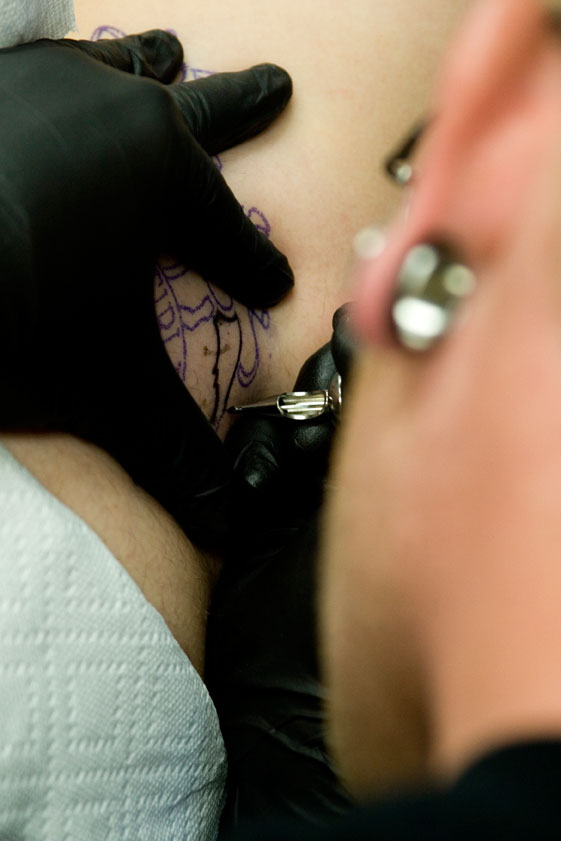 |
|

| Majestic Makeover |
| En Pointe |
| Menace to Masterpiece |
| A Way with Words |
| The Art of Giving |
| Making it Write |
| Tattoo Taboo? |
Tattoo Taboo? Redefining Body Art |
||||||||
| Lauren Maggio | ||||||||
Houstin Smith prepares a design on carbon copy paper and fills three tiny cups with varying shades of black and gray pigment. The canvas in front of him is bare and smooth, eager to be inscribed for the first time. Smith dips his pen into the center ink cup, leans in and situates himself, ready to begin drawing. But before touching his pen down to start the first line he reminds his canvas to relax and breathe deeply.
Smith, who has been into art his whole life and works at Blue Lotus in Madison, says no other art form compares to tattooing. “No matter how much you paint or sculpt or draw, use acrylics, oils, pastels—anything—there’s nothing else like the technical aspect of it or the form of application. Sometimes it still freaks me out.” What’s to be afraid of? “The skin is a living thing, unlike paper. You can’t erase. It’s like a sponge and if you go over it too long or too many times you can tear it up,” said Jesse Siewert, a tattoo artist at Blue Lotus. “It’s a moving, living canvas that’s fragile and will scar if you do something wrong.” Once associated mainly with sailors, gangsters and criminals, tattooing has now extended to almost every social class. In doing so, the scope and complexity of its art has evolved to meet new client demands. Though practiced for centuries around the world, a social stigma dogged tattooing in America through most of the 20th century. Health code issues and underage concerns prevented tattoo licensing in Milwaukee County until the mid-‘90s. The disapproval of tattoo clientele had many surrounding areas following suit on the ban for fear that the “rebels” would be drawn from Milwaukee to their communities to get inked. Bill Hanson was one of the first to break the status quo by opening his shop, Black Dragon Tattoos, in Waukesha. With nearly 30 years of professional experience, Hanson has witnessed the evolution of tattoos from a rebellious statement to a mainstream trend. “We had a reputation situation that took years and years to overcome. There was a stigma of who had tattoos and why,” Hanson said. In the '60s and '70s the tattoo scene was still very much underground but was expanding to people without military background or criminal records. Chinese and Japanese-themed art emerged, bringing more color, intensity and symbolism than the all-black sailors’ anchors and line drawings of the past. Hanson said as the '80s dawned, tattoos entered the workplace as professional women, such as nurses and secretaries, requested small, color pieces with intricate designs. “We artists had to bring the art form up to meet these new standards. The girls wanted things with more art and higher levels of detail,” Hanson said. With raised standards and expectations, tattoo artists had to work more imaginatively, encouraging the advancement of tattooing as an art form. “It used to be you’d see the shops with flash drawings up on all the walls in three colors. These guys couldn’t really draw, [the tattoos] were really simple and basic,” Siewert said. “Now we look at the tattoos and they look like oil paintings on skin.” Smith said though the tattooing machine has been the same for 150 years, pigments have become a lot more dynamic. |
||||||||
1 | 2 | 3 print this article |
||||||||
About Us | Contact Us | Business Partners | Archives | Sitemap
Copyright 2007 Curb Magazine
